Cleaning sewer pipes: 3 ways to restore drainage
Any sewage system has one unique feature - to stop working at the right time. Many of the formation of a blockage enters into a stupor and makes urgently call the plumber on duty or an emergency team. But not so difficult and cleaning the sewer pipes with their own hands. It is only necessary to have the necessary means and to strictly follow the sequence of actions proposed below.
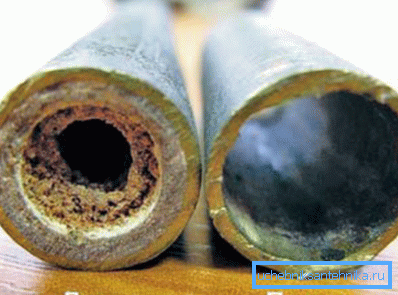
Causes of blockages and methods of dealing with them
Obstruction of the sewer system appears due to blockage of pipes. Sometimes the cause may be a large foreign object caught in the drain hole. But more often a cork is formed due to the deposition of organic and inorganic residues on the inner surface of the pipeline.
Regardless of the circumstances, sewer pipe cleaning can be carried out using the following methods:
- using chemicals, containing sodium;
- by mechanical means (plumbing cable, special wire or steel tape);
- using a special hydrodynamic installation, which flushes sewer pipes under high pressure water.
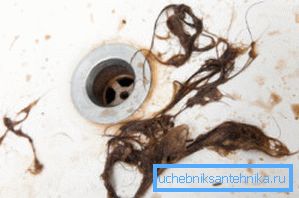
Everyone can use all these methods, but some of them require specialized equipment, the price of which can be quite high.
Also, special care should be taken to clean plastic sewage pipes, since some types of polymer parts have brittle walls and can be destroyed by mechanical action.
Before starting work, it is advisable to disassemble the drain siphon located under the sink or bathroom (this device creates a water seal that prevents unpleasant odors from entering the apartment). Perhaps the cause of obstruction of sewage lies in it.
It is necessary to thoroughly rinse all of its parts and install into place. If the problem is not solved, you need to move to more radical measures.
Self flushing sewer network
Method 1. Use of household chemicals
Before starting work, it is necessary to purchase special formulations containing sodium in the hardware store, which softens plaque on the pipe walls and facilitates their removal.
Chemistry to clean sewer pipes requires careful handling. Regardless of the form of release (gel, granules, liquid, powder), before using it is necessary to familiarize yourself with the attached rules. The instructions are usually printed on the back of the package.
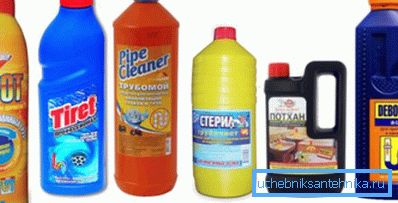
Substances in the form of powder work longer, therefore, preference should be given liquid. Country of origin does not affect the quality and effectiveness of the drug. The main thing is to make sure that the product you purchased does not destroy the polymer from which the sewer system is constructed.
During work, do not forget to observe the following rules:
- cleaning is necessary only in protective rubber gloves;
- Make sure that the chemical does not fall on the open skin, and even more so on the mucous membranes (eyes, nose, mouth);
- pour or pour the compound into the drain hole so that it does not splash, as this may damage clothing;
- carefully follow the dosage specified in the instructions for use;
- After work, you need to flush the drain system with plenty of clean water to remove residual matter and debris from the pipeline.
Tip! Preparations for eliminating sewage blockages can also be used for preventive purposes. This will not only avoid the formation of cork in the drain pipe, but also prevent the appearance of an unpleasant smell in the bathroom and toilet.
Method 2. The use of mechanical devices
Not all types of blockages can be eliminated with the help of day-containing drugs. Sometimes the cork can be too tight. In this case, you need to use mechanical cleaning tools.
These include:
- plumbing cable;
- metal tape;
- borax, spiral loops and so on.
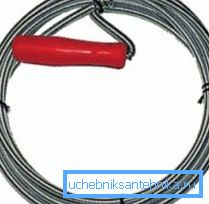
Despite the differences in appearance, they all act according to the same principle: with the help of a tip, a physical impact on the blockage is carried out, with the result that it collapses, and the remains of garbage are discharged into the central sewage system or individual septic tank.
In the absence of a special device, you can use ordinary steel wire. It only needs to be flexible enough. To extract the hair or fibers of textiles, you can use the nozzle in the form of a hook.
The advantages of the cable are that, due to its spiral construction, it passes all the corners and curves of the drainage system well. In addition, this device is equipped with a handle, with which you can make rotational motion. Depending on the diameter of the pipes, products of various sizes are used.
The process itself will not cause much difficulty. It is advisable to stock up on buckets, rags and mops in advance, and also to put on some old things that you would not be sorry for.
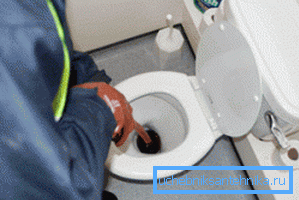
Method 3. Using hydrodynamic installation
In order to eliminate the blockage with the help of strong water pressure, it is necessary to purchase or rent a special device that runs on electricity or gasoline. A special compressor supplies high pressure water to the hose. This allows you to effectively clean the pipes and eliminate even the most difficult blockages.
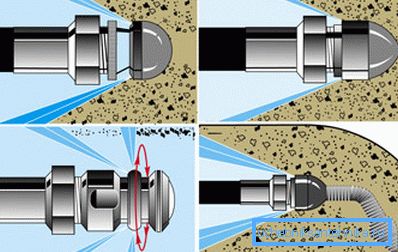
The process is simple:
- a special hose is inserted into the drain pipe until it hits the blockage;
- the water supply turns on and the device starts;
- a strong jet of water breaks the crushed debris and pushes it to the drain well.
In the absence of a special device, you can use a garden hose for watering. To do this, it connects to a water pump, which is also able to provide a sufficiently strong pressure of the water jet.
Some homegrown masters have adapted cleaning vacuum cleaners to clean the sewers. Need a model that has the option of cleaning surfaces with water supplied under strong pressure.
Note! When self-hydrodynamic cleaning of sewage it is necessary to take into account several factors: the force of water pressure, the presence of solid waste in the pipeline, the material of the sewer system, and so on. Improper work can damage plastic parts, which will necessitate their dismantling and replacement.
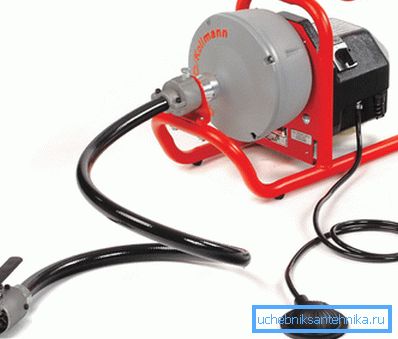
In conclusion, we give another way.
To do this, you need a regular vacuum cleaner and plunger:
- A wooden part is removed from the wooden handle of the plunger, after which a hole is cut in it that coincides in diameter with the suction hose of your vacuum cleaner.
- Then this part is connected to the hose and fixed on it with the help of ordinary clamps for pipes.
- The hose connects to the hole that blows air (it is on the opposite side of the vacuum cleaner). Naturally, the design of your device should provide such an opportunity.
- Then the hose with a homemade tip is pressed against the drain, after which you need to turn on the device at full capacity.
Conclusion
Chemical, hydrodynamic or mechanical cleaning of sewer pipes will help to quickly eliminate the blockage and resume the operation of the drain system. However, if traffic jams form too often, perhaps the reason lies in the mistakes made in the design or installation of sewers. You can learn more about this in the video in this article.